Dazzled by the splendour of the Taj Mahal
India’s Taj Mahal, with its glistening white marble exterior, is probably one of the world’s best-known and most-loved sights.
It’s so dazzling, so beautiful and so elegant that it’s sometimes a stretch to remember that it’s a mausoleum and a tomb.
Mughal emperor, Shah Jahan, had the Taj Mahal started in 1632 to honour the memory of his beloved third wife, Mumtaz Mahal, who died the previous year while giving birth to her 14th child.
The main structure took 17 years to complete and is considered the greatest achievement across the whole range of Indo-Islamic architecture.
It’s a wonderful mix of solids and voids, arches and domes, and intense colours. White marble against a deep blue sky, flashes of precious and semi-precious stones, hues of lush plants in the surrounding gardens, even the reddish gravel on the paths work together to showcase the Taj’s ever-changing moods.
I think it’s fitting to record the names of some of the people who helped to create this fabulous complex. Ustad Ahmad Lahori was the main architect. Ustad Isi Afandi prepared the site plan. The stylish calligraphy is attributed to Amanat Ali Khan Sharazi, while Ran Maj from Kashmir designed the gardens.
Thousands of masons, stone-cutters, inlayers, carvers, mosaicists, painters, calligraphers, dome builders and other artisans came from all over the empire, as well as Central Asia and Iran. After finishing the white marble centrepiece, the workers stayed on for another five years to build a mosque, a guest house, the main gateway on the south, and the outer courtyard and its cloisters.
The Taj sits on 17 hectares of gardens that are divided into four parts. Unusually, the tomb was placed at the back of the landscape rather than in the centre, which is why visitors approach it across a wonderful and long vista.
It’s that long view that really emphasises the Taj Mahal’s beauty and form. Instantly you can see its four matching minarets, its symmetrical design, its many arches, its brilliant white colouring, and the crowds who flock to visit.
We were allowed to enter the Taj, but not allowed to take pictures and, unusually for me, I complied.
Once inside the main chamber, we trooped along with the crowd and were able to walk around the cenotaphs of Mumtaz Mahal and Shah Jahan. An exquisite octagonal marble lattice screen encircles both cenotaphs. It’s highly polished and decorated with inlays of precious stones representing flowers.
Mumtaz Mahal’s cenotaph is on a platform in the exact centre of the double-storied tomb chamber. Shah Jahan’s cenotaph, built more than 30 years after his wife’s, is larger, but no more beautiful.
Cenotaphs are empty tombs, and the actual graves are in a lower tomb chamber (crypt) that is not open to the public.
As we approached the Taj, we walked through the magnificent ornamental gardens, surrounded by the main gate, the mosque, the guesthouse and a sort of viewing platform near the middle.
The garden, called the Bageecha, is laid out symmetrically with white marble water channels, studded with fountains and lined by cypress trees. There are said to be 64 flowerbeds with 400 plants in each bed. The channels used to have colourful fish.
The enormous and majestic Darwaza, or southern gateway, is a three-storey red sandstone structure with an octagonal central chamber. It’s 150 feet long and 100 feet high. The main arch is inscribed with verses from the Koran, written in Arabic calligraphy. The script gets larger as it goes up the wall, giving the verses a uniform appearance to the untrained eye. The many domed pavilions on top are Hindu in style and signify royalty.
The mosque and guesthouse are twins, built identically. I have to confess that I’m not sure which is which in my photos. Poor John can’t remember either (unusual lapse of memory for him). Judging from the scaffolding, one of the two was being maintained/repaired when we visited. Both have been built with the same stunning sandstone as Fatehpur Sikri.
The Taj Mahal complex sits on the Yamuna River, and the water channels used to be, and probably still are, fed by the river. Across the river you can see the beginnings of another mausoleum/tomb. We were told that Shah Jahan wanted to build a black marble mirror image of the Taj Mahal. His son put a stop to that.
Poor John reckoned that the son didn’t want his dad to squander the money on yet another monument, but from what I’ve read, the son totally supported the construction of the original Taj, so maybe he thought two monuments were overkill.
Speaking of overkill, I was stunned to see all the items that aren’t allowed into the Taj Mahal compound. Good grief, I can accept the need to keep out explosives, but toys and books? I think I might have had a guide book in my backpack. Bad Peggy.
P.S. It was grey and hazy on the day we visited, so the sky isn’t as blue as it could be. Frankly, I’m surprised it looks as good as it does.
P.P.S. Next stop Agra Fort, which is just a few kilometres from the Taj.

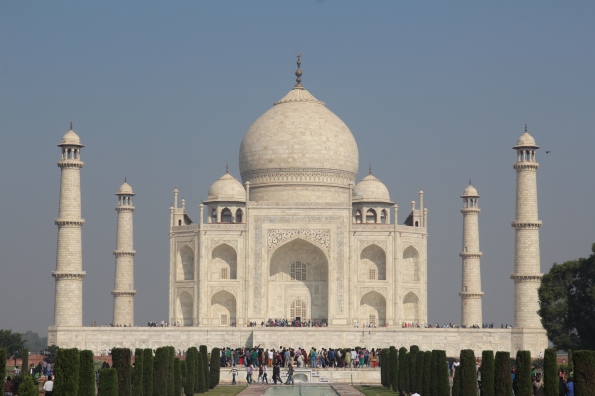








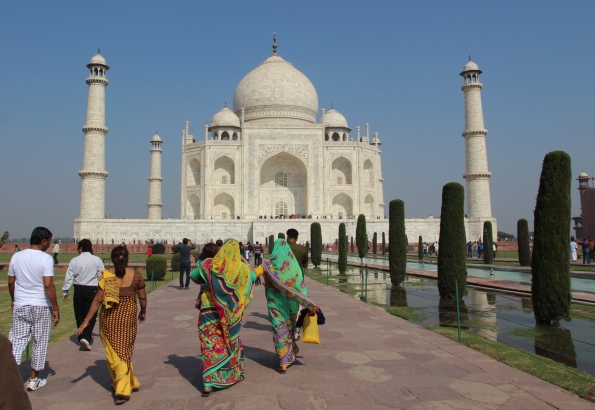
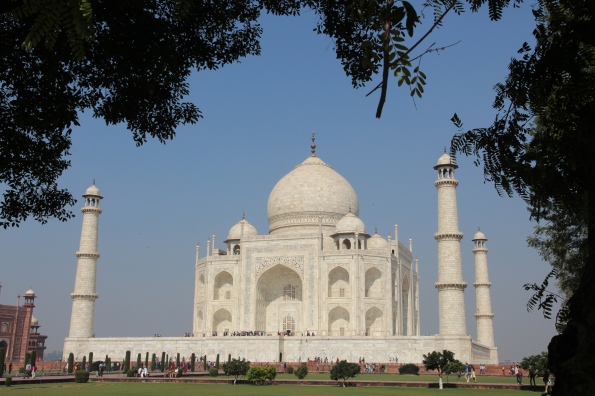
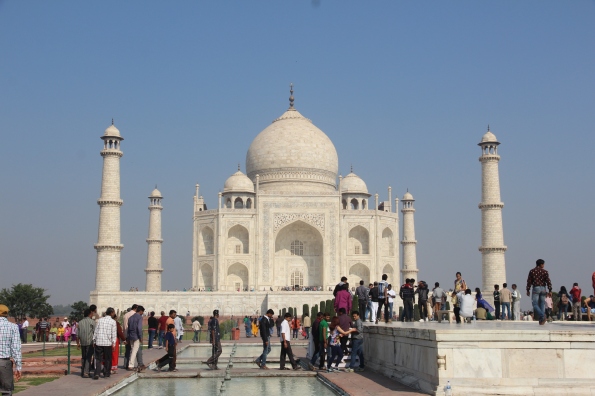
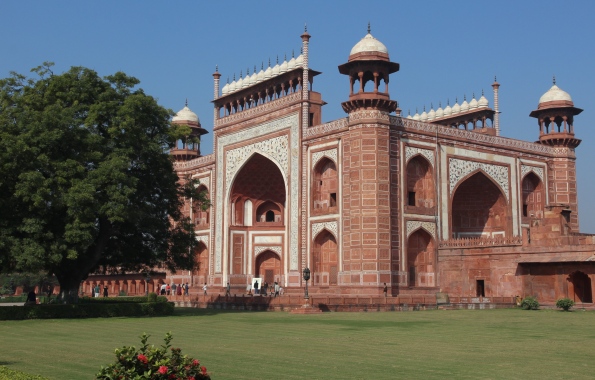







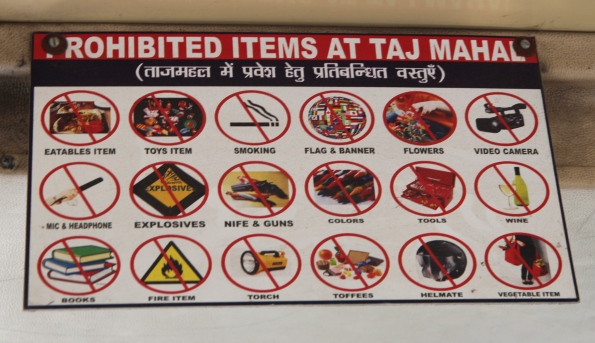
I see also you cannot take your “HELMATE” is in the prohibited items in either – no fun at all.
LikeLike
I was disappointed I had to leave my TOYS ITEM outside.
LikeLike
We just returned from a trip to Aurangubad and saw the Poor man’s Taj
I cannot wait to see the real one!!! 😀 beautiful photos x
LikeLike
Oh wow, I didn’t know there was a poor man’s Taj. I’ll have to come back to see it. You’ll love the real one. Let me know when you get there.
LikeLike
Such a beautiful building – I was prepared to be underwhelmed but it was utterly stunning. The most lovely man-made structure I think I’ve ever seen. And yes, we had a small bear on a keyring that we had to leave in a locker!
LikeLike
So glad you’ve had the chance to see it too. A truly fabulous building. But relieved that your ‘attack’ bear wasn’t allowed in. 🙂
LikeLike
“What”… No Peacocks nowhere ? Wondering now just what part of the Universe you intend to visit next 🙂
LikeLike
Oh my gosh, you are so right. no peacocks! We saw them in the national parks but not at the Taj. A mystery. Our next travels aren’t a mystery—the Silk Road again starting in May. Then India again later in the year.
LikeLike
I understand that its free for citizens, but charge for tourists ..is that true? Interesting list of prohibited things…long rules like that almost always brings out the rule breaker in me… I would have a problem with the picture taking thing…it is a lovely place tho..
LikeLike
Oh yeah, the rules bring out the devil in me. Video cameras aren’t allowed, but my camera takes movies, so what’s the difference? As for photos inside the Taj—it’s dark, crowded and there are as many lovely things to snap outside. I didn’t mind.
As for admission, I think everyone has to pay, but Indian citizens are admitted for a vastly reduced rate.
LikeLike
Hello Sylvia.. Taj mahal entry is cheaper for citizens than tourist but not free. We Indians also have to pay some amount of money to see beautiful things. It’s true they have made so many rules, but some aren’t silly such as do not spit or touch important monuments or pluck flowers from gardens. And if you have any digital camera or any HD camera you can make videos and take pictures very easily, and the officials don’t know.
LikeLike
Hello Peggy,
Another especially good blog. How can you miss, with the Taj being the number one tourist site to visit. The photos are excellent and even if it was taken on a slightly hazy day, it makes the light a little softer (less glare then mid-day glaring sun) and good shots. I like the one with the two woman in colorful sari’s walking toward the Taj and reflection pool on the right side. And like always your detailed commentary helps us all better know this place. It has been 40 years since I had been there, so I appreciate the images and comments. Also, nice to see that many of the semi-precious stones are still in place and the thieves have not gotten around to “Lifting Them Off.”
The sign about what is not allowed is kind of funny, from a Westerner’s point of view. Too bad you could not take your toy (must have been a yellow rubber ducky) along, a hard covered book (to whack a bad tour guide or tourist on the head) or a “nife” (to pry off some semi-precious stones, white standing on Poor John’s shoulders to try and reach the higher ones LOL).
Thanks,
Sy S.
LikeLike
I love the photo of the two women too. Probably my favourite in the bunch. I’m glad you appreciate the commentary. Each post takes some time to compile because I don’t want to use someone else’s words.
I like the idea of taking a hardcover book to whack an annoying tourist with. Must remember for future reference.
LikeLike
Excellent – and new to me! – information and photos on the Taj Mahal! I always enjoy your postings, but this one may be in the top five or so for me.
LikeLike
Wow, thanks so much! It really is a fabulous building—a true wonder of the world! The first time I visited it was in 1981.
LikeLike
We visited the Taj some years ago Peggy, and without a doubt, it’s one of the most amazing buildings in the world. I love the incredible inlaid stonework. In fact, we bought a small inlaid table top in the market, that we still have to this day. It has survived all our rounds of simplifying and downsizing, which is saying something. Nice post and photos. ~James
LikeLike
Thanks! The inlay work is so intricate and delicate—done by true craftspeople. No wonder you’ve hung on to that table top. We saw the Taj the first time in 1981 and we might make it back again this year. Fingers crossed.
LikeLike
The black shrine across the river for him was stopped by the son from my understanding due to India’s lack of money to pay for such an extravagance. The shrines were to be facing one another forever as they were lovers in life.
I’m jealous, one of the top bucket stops on my list of places in the world to see!
LikeLike
You are right. The shrines were to face one another—one white and one black. Wouldn’t that be a sight!
LikeLike
The gates are even magnificent! It is so amazing that so much money was/is spent on such luxury when so many people need so much however what I’m not educated on is what these leaders did for their people at the time. It’s just a running thought that always seems to run through my mind over and over.
LikeLike
It’s a logical thought to have, Dave. It still happens today, with leaders squandering their country’s money on lavish structures. Here’s an example in Turkmenistan.
LikeLike
We really enjoy your blog and specially pictures.
LikeLike
I really appreciate you visiting. 🙂
LikeLike